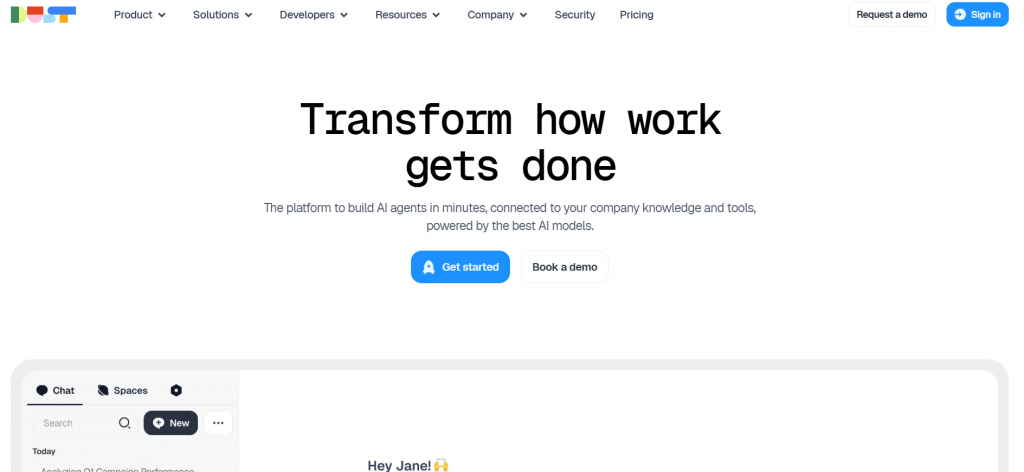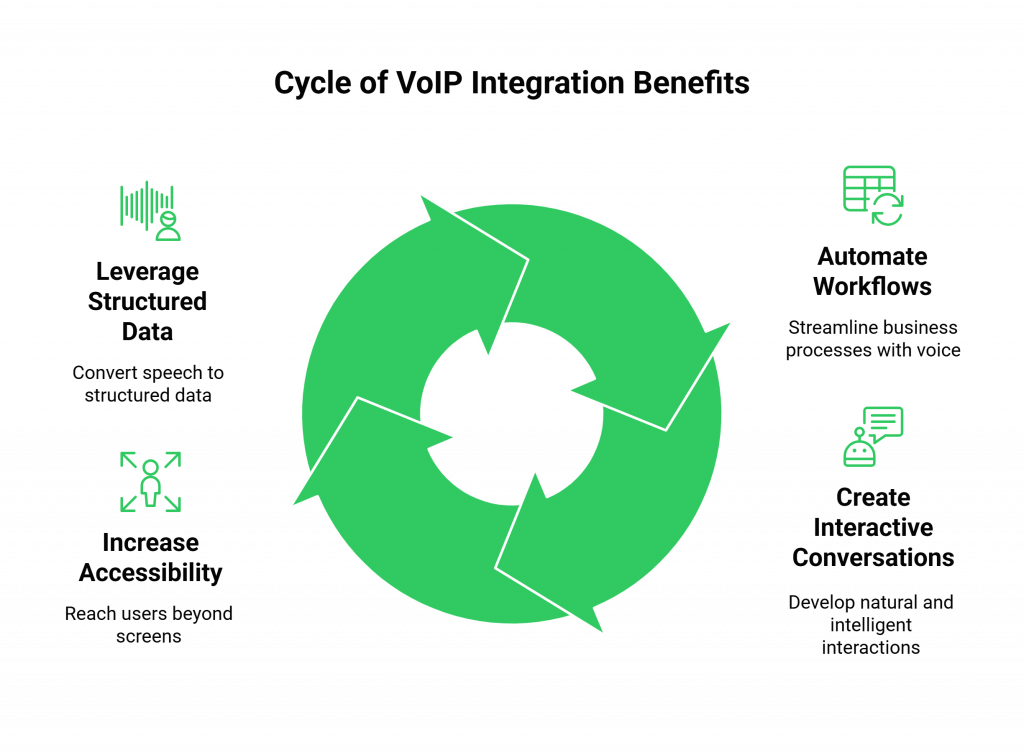Developers are flocking to platforms like Dust.tt to build sophisticated LLM-powered applications and assistants. With its powerful tools for orchestrating complex workflows, connecting to data sources, and managing application state, Dust.tt lets you build an AI that can truly think and act.
But even the most brilliant AI assistant faces a fundamental limitation: it’s trapped behind a screen, communicating only through text. What if your assistant could break free from the chat window and interact with the world in the most human way possible, by talking?
This is precisely why developers are turning to a transformative technology: VoIP Calling API Integration for Dust.tt.
Imagine an assistant you designed in Dust that can call a new sales lead, have a natural conversation to qualify them, and then update your CRM, all on its own. This isn’t a futuristic concept; it’s the next practical step in application development.
This guide will explore the top reasons why developers are giving their Dust assistants a voice and how this integration fundamentally expands what their AI can achieve.
Table of contents
What is Dust.tt? The Power of Structured LLM Apps

Before diving into the “why” of voice integration, it’s essential to understand what makes Dust.tt so powerful for developers. Dust.tt is a platform for building and deploying production-grade Large Language Model applications. It goes beyond simple prompting and provides a structured environment to create robust, multi-step AI workflows.
Key Strengths of Dust.tt Include
- Structured Workflows: You can chain together different steps (LLM calls, code execution, data lookups) to create complex logic that is easy to manage and debug.
- Data-Aware Assistants: Dust allows you to connect your assistants to your own data sources, like databases, APIs, and internal documents, giving them the context they need to perform useful tasks.
- Developer-Centric: It is built for developers who need full control, versioning, and the ability to programmatically deploy reliable applications via API.
In short, Dust.tt provides the tools to build the “brain” of a highly capable AI assistant. Now, let’s explore why that brain needs a voice.
Also Read: Building Smarter Apps with VoIP Calling API Integration for Pipecat AI
The Top 4 Reasons for VoIP Calling API Integration for Dust.tt
Adding voice is not just a novelty; it is a strategic decision that unlocks new capabilities and automates entire classes of real-world tasks.

To Automate Voice-Based Business Workflows
Many of the most critical business processes are still conducted over the phone. Customer support, appointment scheduling, sales outreach, and order confirmations are all prime examples. A text-only assistant simply cannot participate in these workflows. A VoIP Calling API Integration for Dust.tt allows your assistant to become an active participant.
- Real-World Example: Imagine you build a Dust App to manage e-commerce order logistics. When an order is flagged for a potential address issue, your Dust assistant can be triggered to automatically call the customer. It can ask them to confirm their shipping address, process their spoken response, and update the order in your system, all without any human intervention.
Also Read: How Does VoIP Calling API Integration for LangChain AutoGen Microsoft Works?
To Create Truly Interactive and Stateful Conversations
A phone call is a dynamic, back-and-forth exchange. To be effective, an AI agent needs to remember the context of the entire conversation, not just the last message. Dust.tt’s ability to manage application state is perfectly suited for this. When combined with a voice interface, you can create conversations that feel natural and intelligent.
- Real-World Example: A developer could build a technical support assistant in Dust. When a user calls, the assistant can guide them through troubleshooting steps. Since Dust maintains state, the assistant can recall which solutions have already been attempted. If the user says, “I already tried restarting it,” the assistant can consult its logic and move to the next potential solution instead of repeating itself.
To Deploy AI Beyond the Screen and Increase Accessibility
Not every user interacts with technology through a web browser or a mobile app. The telephone is the most universally accessible interface on the planet. A VoIP Calling API Integration for Dust.tt allows you to deploy your powerful assistant to anyone who can dial a number.
- Real-World Example: A city government could use Dust.tt to create an assistant that provides information on public services. By connecting it to a phone number, they make this information instantly accessible to elderly citizens, people in rural areas with poor internet, or anyone who simply prefers making a phone call.
To Leverage Dust.tt’s Structured Data Capabilities in Real Time
Dust.tt excels at taking unstructured information and turning it into structured data that can be used in an application. A voice conversation is, by nature, a stream of unstructured audio data. A VoIP API acts as the perfect pre-processor. It transcribes the user’s speech into text, which can then be fed directly into your Dust App to be parsed, analyzed, and stored in a structured format.
- Real-World Example: A marketing team could build a Dust assistant to conduct phone surveys. The assistant calls a user, asks open-ended questions, and streams their responses into the Dust App, which transcribes the speech, extracts key entities (like product names or sentiment), and populates a structured data table for real-time analysis.
Also Read: How VoIP Calling API Integration for CrewAI Improves AI Agents?
The “How”: A Technical Blueprint for Integration
Connecting your Dust App to a voice interface involves four core components working in a high-speed loop.
- Your Dust.tt Application (The Brain): The workflow you’ve built, which can be run via its API endpoint.
- A Voice Infrastructure Platform (The Voice): Your VoIP API provider, which manages the phone call and the real-time audio streaming.
- A Speech-to-Text (STT) Service (The Ears): An AI model that transcribes the human’s spoken words into text.
- A Text-to-Speech (TTS) Service (The Mouth): An AI model that converts your Dust App’s text response into a natural-sounding voice.
The conversation flows in a cycle: The user speaks -> The STT transcribes the speech to text -> The text is sent to your Dust App’s API endpoint -> The Dust App runs its logic and returns a text response -> The TTS converts this response to audio -> The audio is played to the user. This entire cycle must happen in under a second for the conversation to feel natural.
Conclusion: From Smart App to Autonomous Agent
The reasons developers are pursuing VoIP Calling API Integration for Dust.tt go far beyond adding a “cool” feature. It’s about fundamentally expanding the scope of what their AI applications can do. It’s about moving from building smart tools that require a user to be at a computer to deploying autonomous agents that can actively participate in the real world.
By combining the structured, data-aware logic of Dust.tt with a reliable, low-latency voice interface, developers are creating the next generation of AI that can truly communicate, assist, and automate.
Also Read: SIP Trunk Providers: How to Choose the Right One for Your Business
Frequently Asked Questions (FAQs)
Dust.tt is a platform that helps developers build and deploy applications powered by Large Language Models. It allows you to build structured, multi-step workflows. You can also connect them to your own data. This makes your AI assistants more powerful and reliable.
The voice infrastructure platform uses a Speech-to-Text (STT) service to convert the user’s audio into text. This text is then sent as a standard API request to your Dust App’s unique API endpoint.
Yes. A well-designed voice integration ensures your Dust App completes its workflow, database lookups, API calls, and all before converting the final response into speech.
Latency. This is the delay between when the user stops speaking and the agent starts replying. For a conversation to feel natural and not frustrating, this latency must be extremely low, ideally under one second.
